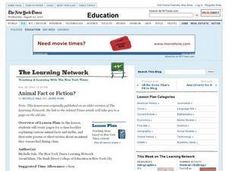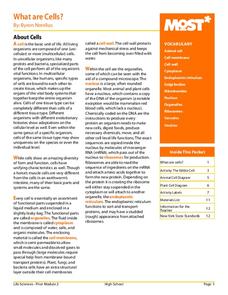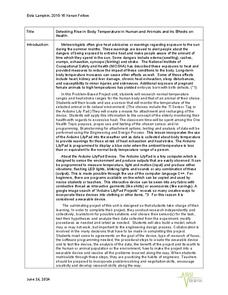SeaWorld
Animal Migrations
Here is a fabulous set of activities for your young scientists. Each lesson contains map, hands-on, and game activities that will help the class understand why and how animals migrate from one place to another. First they'll examine the...
Kindergarten Mom
Animal Alphabet Chart
Engage young children in learning the letters of the alphabet with a fun animal alphabet chart. With the letters written in both upper and lower case and accompanied by pictures of animals beginning with each letter, this is a great...
Curated OER
Animal Farm: Symbolism and Theme
If you want some help with teaching themes and symbols in Animal Farm, this may be beneficial. After a class discussion about possible themes, class members write a paragraph explaining which they believe is the most important. Next,...
Curated OER
Natural Resources: Can We Use Them Forever? Grade 2
Bright colors and animation are great ways to attract a young students attention. Students are introduced to the concepts of renewable and non-renewable resources as they pose the question, will our resources be around forever? This...
Curated OER
Welcome Back to the Computer Lab: Starting a New School Year
Get kids re-oriented to the computer lab for back-to-school. The constructivist approach in this session allows children to exert ownership of their behavior in the computer lab. Read aloud a few books about good and poor manners, as...
Curated OER
Animal Diaries
Launch this lesson with Doreen Cronin's Diary of a Worm! Discuss the format and content of a diary, and ask learners if they've ever kept a diary before. Then, after an introductory discussion, have learners choose an insect or another...
Curated OER
Music and Animation: 200 Greatest Pop Culture Icons
Music has been used to convey thoughts, feelings, and the human condition for thousands of years. Your class will analyze several songs hear in the animated classic, "Charlie Brown." They will listen to several jazz pieces from the show,...
Curated OER
Desert Animal Sorting
What makes certain animals better suited for desert life than others? Explore the differences between desert and non-desert animals with this picture sorting activity. Be sure to print the worksheet in color so learners can observe and...
California Academy of Science
Natural Resources Bingo
Bingo isn't just a silly game, it's a great way to practice all types of skills. After reviewing that the earth is composed of natural resources, what those natural resources are, and sustainability, the class plays a game of bingo. The...
Curated OER
Animated Snowman
Students produce a web page with an animated snowman using DHTML and JavaScript. The finished project must work correctly in Netscape 4.7 and Internet Explorer 5.0 on both Mac and PC.
Curated OER
Animal Fact or Fiction?
Read and discuss the article "Welcome to Cicadaville (Enter at Your Own Risk)" to gain a better understanding around the confusion regarding cicadas and locust swarms. In groups your young analysts research statements about animals to...
Curated OER
Animal Alphabet
Review the alphabet and the sounds each letter makes before having learners identify animals whose names begin with each letter. Working in groups of four to six, they make an animal alphabet book with the letter, a picture of the animal...
Curated OER
Animal Diary
Students create a diary of an animal. In this creative writing lesson, students read the book Diary of a Worm and conduct a brief research session on their animal. Students fill in a template with facts and create an animal diary.
Curated OER
Animal Habitats: 1st Grade
Learning about animal habitats can be a lot of fun. This lesson focuses on how God created different habitats to suit different animal needs. Students will conduct library research in order to create a five page habitat slide show using...
Curated OER
Plant and Animal Cells: Alike and Different?
Seventh graders create a mneumonic device and a graphic organizer about the parts of plant and animal cells. In this biology lesson students are introduced to the parts of the cells and then work in groups to create projects that teach...
Pennsylvania Department of Education
Animal Classes and Their Ecosystems
Students explore animal characteristics by participating in an environment identification activity. In this animal habitat lesson, students discuss a range of different wild life and the ecosystems that they are a part of. Students view...
K12 Reader
Competing for Resources
Young biologists examine the concept of scarce resources with a reading comprehension passage. After finishing the paragraphs, learners turn to the questions to demonstrate what they have learned about what is beneficial and what is...
Tellagami Labs
Tellagami
Bring the world of video messaging into your classroom with this creative communication application. Offering the ability to create animations with customized characters, backgrounds, and recorded messages, this resource is guaranteed to...
Houghton Mifflin Harcourt
Animal Encounters: Challenge Activities (Theme 6)
To enrich their study of wild animals, fifth graders create a wildlife photography exhibit, create a book about animals that live in national parks, and plan a wild animal park for the animals living in their area.
Curated OER
Build Your Own Cell
For this building your own cell worksheet, students identify cell vocabulary and facts, and create posters of a labeled plant cell and an animal cell. In this fill-n-the-blank and posters worksheet, students provide twenty-three answers.
Howard Hughes Medical Institute
Niche Partitioning Activity
Dinnertime on the African savanna is a highly choreographed event! Introduce young ecologists to the concept of niche partitioning through a hands-on activity. Pupils research animal behaviors and use data to develop an understanding of...
Channel Islands Film
Dark Water: Lesson Plan 2 - Grade 3
A discussion of bioluminescence launches an investigation of animal adaptations. After re-watching the opening minutes of Dark Water, class members listen to a reading of What Do You Do with a Tail Like This, and then create a new...
Curated OER
What Are Cells?
Energize the cells of young biologists with an edible life science activity. Engaging students in exploring the inner workings of plant and animal cells, this activity involves using colored jello and various sweet and...
Kenan Fellows
Detecting Rise in Body Temperature in Human and Animals and its Effects on Health
Beat the heat using sensors. Scholars research normal body temperatures for humans and a specific animal. In groups, they create sensors that monitor body temperature, as well as the weather. The goal is to reduce the occurrence of heat...

























